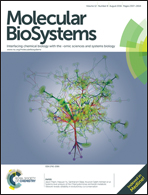Hyperglycemia induced structural and functional changes in human serum albumin of diabetic patients: a physico-chemical study
Abstract
Structural and functional changes in albumin are of particular interest as numerous studies in vivo have reported a strong involvement of glycated-HSA in the development and progression of chronic diabetic complications. Non-enzymatic addition of glucose molecules to a protein induces structural changes in it. These changes depend on the degree of glycation. In this study, conformational changes in glycated-HSA and its antioxidant capacity were evaluated. HSA was purified from diabetic patients with/without CKD and healthy subjects. Glycation induced an increase in the molecular mass of HSA as determined by mass spectroscopy. Further secondary and tertiary structural changes were observed by UV, circular dichroism (CD) spectroscopy, Fourier transform infrared spectroscopy (FTIR), tryptophan and 1-anilinonaphthalene-8-sulfonic acid (ANS) fluorescence. The mean α-helix content was found to be 59.46% for normal HSA and it was reduced down to 45.63% in HSA isolated from diabetic patients without CKD and to 37.48% in CKD-HSA. FTIR analysis showed Amide I and Amide II band shifting in HSA of diabetic patients without and with CKD. These findings indicate the secondary structure changes in glycated HSA. The tertiary structure is also affected by in vivo glycation as confirmed by intrinsic fluorescence and ANS fluorescence results. Consequently, these structural changes associated with glycation provoked a reduction in the free thiol group and a strong increment of protein carbonyl contents and the fructosamine level in glycated HSA. Antioxidant activity was evaluated by a RBC hemolysis test. The result indicates that the free radical scavenging capacities of HSA were decreased in diabetic patients with or without CKD. Our study revealed that structural and functional features of glycated HSA, isolated from diabetic patients with and without CKD were significantly different from the HSA isolated from non-diabetic subjects. Moreover these changes were more prominent in HSA isolated from diabetic patients with CKD. These findings suggest that active sites of HSA may not be available under extensive glycation, leading to the impairment of its important functions. Thus glycated HSA may be involved in the pathogenesis of diabetes and its complications such as chronic kidney disease.


 Please wait while we load your content...
Please wait while we load your content...